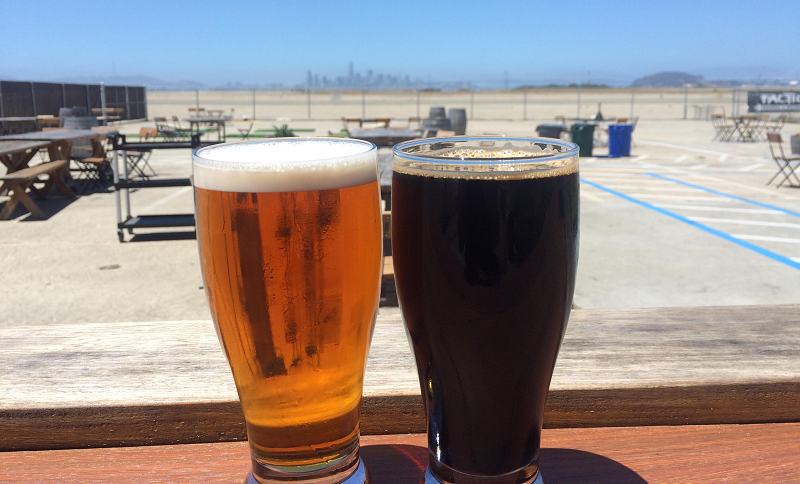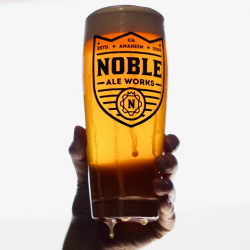The Delicious Deception of White Stouts
The pour is a deep gold, the head a rich blossom of off-white foam. But as you raise the glass, you start to wonder if you’re a little delirious. In fact, a quote from Shakespeare’s King Lear seems appropriate: “All that follow their noses are led by their eyes but blind men.” These scents, they belong elsewhere: They’re all chocolate, roast and coffee. And the silky mouthfeel and flavor profile indicate this should be a stout—but it isn’t?
“It’s a sweet blonde ale—we can’t really call it a stout per se,” says Rodger Davis, brewer and co-founder of Faction Brewing Co., whose Anomaly White Stout shows up every summer in the brewery’s taproom in Alameda, California. “The goal is to mimic exactly what a stout would taste like.”

Faction Brewing Co.’s Anomaly (left) doesn’t look like a stout, but shares many of the same tasting notes. (Photo courtesy Faction Brewing Co.)
White stouts are more of a blip than a movement. From Faction’s Anomaly to Noble Ale Works’ Naughty Sauce, to examples from breweries in the Carolinas and Cascade Brewing Co. in Oregon, the style has reared its enigmatic head on more than one occasion.
Davis first encountered the idea of a white stout via brewmaster Steve Altimari of High Water Brewing Co. Though he initially scoffed at the concept, it grew on him over time and, after testing out an iteration at his old position at Triple Rock Brewery in Berkeley, California, he sculpted his idea into the Anomaly found at Faction today. A large piece of his inspiration has to do with challenging preconceptions—as Faction proudly displays on its website, its name is a nod to individuals that divert from the common thoughts of a larger group.
“We kind of got inspired by all the people that say they don’t like dark beers,” says Davis.
Unwilling to try a dark beer solely because of the color? “Well here’s all the flavor compounds [in a blonde ale] since you’re close-minded,” he says.
At Noble Ale Works, in Anaheim, California, head brewer Brad Kominek takes a similarly cheeky tack with the brewery’s Naughty Sauce White Stout. “There’s nothing wrong with stouts with roasted malt and the normal look of stouts,” wrote Kominek. “We were just trying to do something different, and perhaps give the drinker a little mind-f***. We liked the idea of someone saying, ‘How does it look like this, but taste like THIS?!’”
To pull off the “red plastic cup” trick (i.e. eluding visual rejections) at Faction, Davis loads Anomaly’s blonde ale base with cocoa nibs and cold brew coffee, as well as star anise, in order to mimic the roasted malt characteristics of a traditional stout. He also adds lactose to round out the beer with sweetness, and nitrogenates the beer for a creamy stout-like texture.
“There’s a lot of people that get their minds blown,” says Davis. “With the lactose in there, it can taste like an ice cream melted in your glass.”
Noble, meanwhile, uses residual sugars from the malt bill, oats, coffee, and a “decent amount” of lactose, along with nitrogenation, for a stout-like effect. “Having some residual, unfermentable sugars make the body seem pretty full,” wrote Kominek. “The coffee roast level is medium-ish and we only use light colored malt. Most malt character, such as cracker or biscuit, are mostly stepped on by the coffee.”

Legal Remedy Brewing Co.’s World Court Mocha Blonde Stout. (Photo courtesy Legal Remedy Brewing Co.)
At Legal Remedy Brewing Co., in Rock Hill, South Carolina, head brewer Zach McNeely uses what increasingly appears to be defining “white stout” flavor anchors—coffee and chocolate—to induce the code switch in its World Court Mocha Blonde Stout. Legal Remedy’s version uses white chocolate natural flavor in place of cocoa nibs, directly steeps whole coffee beans in the beer, and does not include lactose. Flaked oats and flaked barley give World Court more body, like a stout, as well.
“We brew it with basically all the ingredients that you would put into a stout minus the roasted barley or the black malt or all that,” says McNeely. “It’s a popular drink, or at least ours is, among the crowd that drinks those Starbucks mocha drinks. Because it honestly tastes a lot like one of those.”

(Photo courtesy Noble Ale Works)
To be specific, the beer is redolent of Starbucks’ White Chocolate Mocha, and (in my opinion) is better the fresher you drink it, as the coffee component of the beverage is best at its brightest. The carbonation is a little more pronounced than I would have imagined, but despite that, it was easy to pull the “red plastic cup” trick on more than one person using World Court.
Legal Remedy makes more of this beer than any other—about 1,200 gallons per week. McNeely says that both those new to beer and more experienced drinkers alike find appeal in the beverage. More experienced drinkers find the beer intriguing, he says, while those newer to beer enjoy the familiarity of flavors like coffee and chocolate.
Kominek, who describes Noble’s Naughty Sauce as being on “the sweet side,” says that since Noble gets heavy traffic from sports events, “a sweet beer that tastes like a latte has a broader appeal than an IPA for the general, non-craft-beer-drinking public.”
“Naughty Sauce is often our best seller every week,” he continues, though sales, he says, are closely followed by Noble’s IPAs.

I love how over the years people stretch the definitions of different types of beers. With the experimentation in beers you come up with beers that don’t necessarily fit into one defined category. I recently tried an “India Pale Lager” and was very surprised by the flavors as it was a nice blend of an IPA and a lager. I will definitely need to look up some of these beers to review.
I recently tasted Colorado Springs, CO, Bristol Brewing’s “Summer Stout.” A brilliant blonde/white stout with an amazing nose! Tricked me into thinking I was drinking a classic dark, sweet stout. I talked to the brewer to understand what flavors are coming through: smoked malt, coffee beans, and cocoa nibs. I found a homebrew recipe that almost matches what he told me.